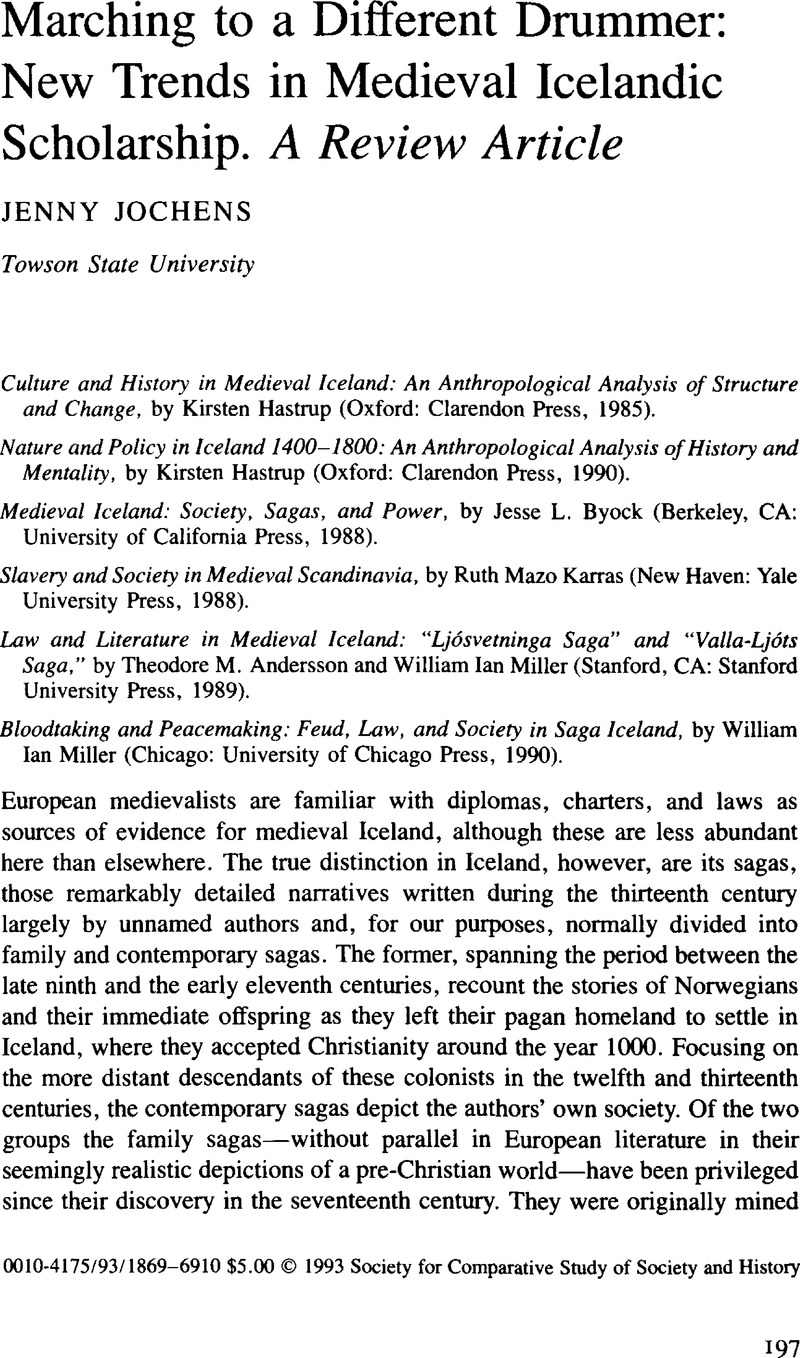Article contents
Marching to a Different Drummer: New Trends in Medieval Icelandic Scholarship. A Review Article
Review products
Published online by Cambridge University Press: 03 June 2009
Abstract

Information
- Type
- CSSH Discussion
- Information
- Copyright
- Copyright © Society for the Comparative Study of Society and History 1993
References
1 For the historiography of the sagas, see Andersson, Theodore M., The Problem of Icelandic Saga Origins: A Historical Survey (New Haven: Yale University Press, 1964)Google Scholar and Carol J. Clover, “Icelandic Family Sagas (Íslendingasögur), Old Norse-Icelandic Literature: A Critical Guide, Clover, Carol J. and Lindow, John, eds. Islandica 45, 239–315 (Ithaca: Cornell University Press, 1985)Google Scholar.
2 Le Roy Ladurie, Emmanuel, Montaillou, village occitan de 1294 à 1324 (Paris: Gallimard, 1975Google Scholar; published in English as Montaillou: The Promised Land of Error, Bray, Barbara, trans. (New York: Random House, 1979)Google Scholar.
3 Lévi-Strauss, Claude, The Savage Mind (Chicago: University of Chicago Press, 1966), 257Google Scholar; de Man, Paul, Blindness and Insight, 2nd ed. (Minneapolis: University of Minnesota Press, 1971), 165Google Scholar.
4 Medievalists may find the January 1990 (vol. 65) issue of Speculum on “The New Philology” particularly useful. See especially the article by Spiegel, Gabrielle M., “History, Historicism, and the Social Logic of the Text in the Middle Ages” (pp. 59–86)Google Scholar.
5 At the Annual Meeting of the Society for the Advancement of Scandinavian Studies, May 1990, two sessions were devoted to “Old Norse Studies and the Concerns of Contemporary Theory.”
6 An English translation is in press; see Meulengracht Sørensen, Preben, Saga and Society: An Introduction to Old Norse Literature, Tucker, John, trans. Studia Borealia, vol. 1. (Marburg-Lahn, Germany: Hitzeroth Verlag, 1992)Google Scholar.
7 Turner, Victor W., “An Anthropological Approach to the Icelandic Saga,” in The Translation of Culture. Essays to E. E. Evans-Pritchard, Beidelman, T. O. ed., 349–74 (London: Tavistock, 1971Google Scholar). Among the narratives, Hastrup considers only Grettis saga. See also her “Tracing Tradition: An Anthropological Perspective on Grettis saga Ásmundarsonar," in Structure and Meaning in Old Norse Literature, Lindow, John et at, eds., 281–313 (Odense: Odense University Press, 1986)Google Scholar. She uses occasional references to Iceland from the Kings' sagas.
8 Hastrup, Kirsten, “Defining a Society: The Icelandic Freestate Between Two Worlds,” Scandinavian Studies, 54 (1984), 235–55Google Scholar; rpt. in Hastrup, Kirsten, Island of Anthropology: Studies in Past and Present Iceland, 83–102, 99, 101 (Odense: Odense University Press, 1990)Google Scholar. Her views are shared by other anthropologists. See, for example, Paul Durrenberger, E., “The Icelandic Family Sagas as Totemic Artefacts,” in Social Approaches to Viking Studies, Samson, Ross, ed., 11–17 (Glasgow: Cruitne Press, 1991)Google Scholar.
9 Byock, Jesse, Feud in the Icelandic Saga (Berkeley: University of California, 1982)Google Scholar.
10 See note 1 and Andersson, Theodore M., The Icelandic Family Saga: An Analytic Reading (Cambridge MA,: Harvard University Press, 1964)Google Scholar.
11 With their rich commentary, Andersson and Miller's translations will undoubtedly come to play the same role as François-Xavier Dillmann's new French translation of Snorri Sturluson's Edda, in which his valuable and copious notes occupy as much space as the text itself (L’Edda: Récits de mythologie nordique par Snorri Sturluson, Dillmann, Françpis-Xavier, trans. (Paris: Gallimard, 1991)Google Scholar.
12 See, for example, his “Choosing the Avenger: Some Aspects of the Bloodfeud in Medieval Iceland and England,” Law and History Review, 1 (1983), 159–204CrossRefGoogle Scholar.
13 Karras, , Slavery and Society in Medieval Scandinavia, 145Google Scholar. See also Nieboer, H. J., Slavery as an Industrial System. Ethnological Researches (The Hague: M. Nighoff, 1910)Google Scholar and Domar, E. D., “The Causes of Slavery or Serfdom: a Hypothesis,” Journal of Economic History, 30 (1970), 18–32CrossRefGoogle Scholar.
14 See Sjöholm, Elsa, Gesetze als Quellen mittelalterlicher Geschichte des Nordens. Ada Universitatis Stockholmiensis, vol. 21 (Stockholm: Almqvist and Wiksell, 1976)Google Scholar. For a recent application of her ideas to the section of Grágás dealing with the riding of other men's horses, see Rafnsson, Sveinbjörn, “Form hrossreiðalög og heimildir þeirra,” Saga, 28 (1990), 131–48Google Scholar.
15 For a recent interaction between archaeology and saga evidence, see Rafnsson, Sveinbjörn, Byggðaleifar íHrafnkelsdal og á Brúardolum (Reykjavik: Hið íslenska fornleifafélag, 1990), 10–25Google Scholar.
- 1
- Cited by

